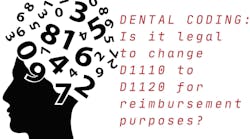“Why is there no insurance reimbursement for (fill in the blank)?”
Picture this: Medieval England and the English guards find Humpty Dumpty has fallen off the wall and is lying in a mess of egg yolk, staring up at them from among his broken shells. The guards calmly look at each other, look down at Humpty, and matter-of-factly say, "It's not that we can't put you back together... it's that the King's Health Care Plan doesn't cover it."1
When it comes to accepting necessary dental services, hygienists have often heard, "I only want what my insurance covers." How do you respond to this? It’s essential for hygienists to be able to speak with patients about what dental insurance coverage is and is not. Most likely, patients don't fully understand dental insurance and how it affects their care.
First identify that dental insurance is a business. In the 1960s and ’70s, most people had some form of hospital or surgical insurance for medical care, but essentially paid their dental costs. It makes sense to think that a prepaid dental plan should encourage dental visits since it covers at least some of the costs.
Unfortunately, this isn't what has happened. Insurers realized that dental insurance is a valid business model because not everyone takes advantage of the benefit. Many people pay for the insurance and never go to the dentist. Unlike medical insurance, which is structured to help when you are the unhealthiest, dental insurance is focused more on preventive care and regular checkups.
What does “dental insurance” actually mean?
The term "dental insurance" can be misleading as it often evokes comparisons with other types of insurance, like car or medical. But dental insurance operates differently than these. People pay a monthly or annual premium for most other insurances, have a deductible to meet, and then have covered benefits. For instance, homeowner's insurance covers the total value of your house. On the other hand, medical insurance has a maximum benefit, but it's usually far above what most patients use.
In contrast, dental insurance can be best understood as a discount plan or even a coupon; some services are covered at 100%, some are discounted at a certain percentage, and some are not covered at all. Some plans may require a deductible, usually as low as $50 to $100, and this deductible typically does not apply to preventive care. The patient is responsible for paying anything over the amount or a percentage of the amount set by the dental insurance plan.
Examples to describe dental insurance to patients
- “You’ve just been given a $2,000 scholarship to the college of your choice. The scholarship committee has established that up to 50% of the amount can be used for tuition, 20% for books and supplies, 20% for housing, and 10% for miscellaneous expenses, such as lab fees. Anything above these amounts is your responsibility, and if you choose not to use the entire amount, the residual will be returned to the committee to be awarded to another awardee. The insurance company is hoping that you do not use your full benefit each year.”
- “You have been awarded a $2,000 gift card. Within the prize description is a clear explanation of how much of that you can use toward your dental expenses and which percentage can be applied to preventive, basic, and major categories. If you choose not to use the amount allocated to a specific category in the benefit year, the award disappears and does not roll over to the next benefit year.”
- The third analogy is probably the best explanation of what insurance should mean to a patient. “You have been given a $2,000 tax-free addition to your annual salary to be distributed as the plan dictates.” Wow! Who wouldn't want untaxed income from their employer as a benefit?
This is essentially how dental insurance plans work. The employee is provided a maximum amount to be spent on dental procedures, and the insurance company determines how it is apportioned. The employee either uses or loses it. Typically, most patients who have dental insurance do not maximize their benefits and inadvertently return any balance to their insurance carriers.
Reimbursement dilemmas
With that in mind, consider the dilemma of reimbursement for dental hygiene services such as D4346, D4355, D4341/D4342, and D4910. Dental insurance carriers have a history of limiting benefits on procedures frequently provided. Historically, these limitations can be based on any of the following:
- Paid according to a negotiated contract between employer and insurance company
- Paid based on a percent of the UCR (usual, customary, and reasonable) computed by the company
- Paid by relying on some form of evidence-based research
- Who knows what?
Unfortunately, there is no simple answer to receiving reimbursement. The latest Google search shows over 200,000 individual dental insurance plans across the country, all with their own specific provisions for reimbursement or no reimbursement (or what we like to call “benefit plan limitations” or “cost containment features”).
The key to receiving reimbursement is providing proper documentation to support the diagnosis of the disease and the rationale for the recommended treatment. But, if the dental insurance plan has limitations or exclusions for a medically necessary treatment to improve your patient's health, the patient must have the education to decide whether to pursue it, even if it is not a covered service. If it is not covered, no amount of documentation will help, and the patient must be responsible for the cost of treatment.
Where hygiene skills can shine
Here’s where hygienists’ skills and expertise in education come into play, and this is where you can shine! Helping patients understand the complexity of dental insurance is vital to case acceptance and achieving optimum oral health.
Hygienists can support the administrative team by providing an overview of what dental insurance is and what it is not and then leaving it up to them to give specifics on their individual plan. Remember, dental insurance should not dictate diagnosis or the treatment plan. It’s a team effort between the business side and the clinical side of dental procedures, all with the purpose of helping patients receive the medically necessary services they need and deserve.
Editor's note: This article appeared in the Aug/Sept 2024 print edition of RDH magazine. Dental hygienists in North America are eligible for a complimentary print subscription. Sign up here.
Reference
- McCoy G, McCoy G. All the Flying McCoys Humpty Dumpty comics. Go Comics. https://www.gocomics.com/search/theflyingmccoys?utf8=%E2%9C%93&terms=humpty+dumpty
About the Author

Kathy S. Forbes, BS, RDH, FADHA
Kathy S. Forbes, BS, RDH, FADHA, brings over four decades of passion and expertise to the dental profession as a clinician, educator, speaker, author, and consultant. Known for turning complex coding topics into clear, practical insights, Kathy helps dental teams connect accurate documentation and coding with quality patient care. Kathy serves as a Director for the DentalCodeology Consortium, where she works with hygienists from across the country to review and develop dental hygiene–related procedure codes and presents testimony annually to the ADA’s Code Maintenance Committee.
Reach her at [email protected].

Connie Simmons, MA, BSDH, RDH
Connie Simmons, MA, BSDH, RDH, earned her BSDH from The Ohio State University and her MA in aging studies from Wichita State University. She’s worked in clinical hygiene for almost 37 years and has other roles in clinical training, sales, speaking, and writing. Her knowledge of dental insurance and coding grew while working with an insurance carrier, and she’s now part of the Dental Codeology Consortium and an associate productivity coach with Inspired Hygiene. She’s also an expert in the clinical use of silver diamine fluoride. Reach her at [email protected].


